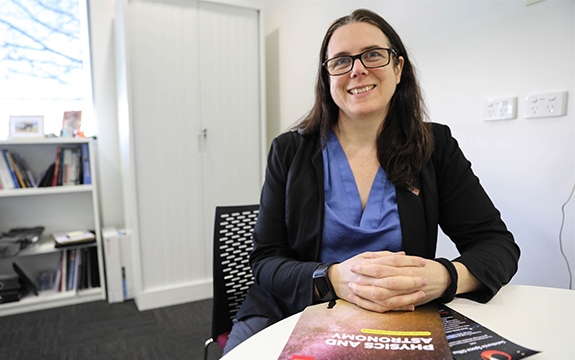New Dean of Science committed to creating opportunities

In Summary
- Professor Virginia Kilborn joined Swinburne’s Centre for Astrophysics and Supercomputing in 2003 and was appointed Dean of Science earlier this year
- As a radio astronomer, her research interests include exploring the evolution of galaxies
- Gender equity initiatives, supporting students and enhancing research outcomes are some of Professor Kilborn’s priorities as Dean of Science
In 1986, Virginia Kilborn peered through her first telescope to watch Halley’s Comet – only visible from Earth about every 75 years.
In the more than 30 years since, Professor Kilborn has become a respected radio astronomer, exploring the evolution of galaxies by tracing their gas content. She joined Swinburne’s Centre for Astrophysics and Supercomputing in 2003 and was appointed Dean of Science earlier this year.
“Being appointed as the Dean of Science is a great honour,” says Professor Kilborn. “It’s a pivotal opportunity for me to promote the exceptional work our teachers, academics and researchers contribute to the field.”
“We have a breadth to our science degree that you don’t get at other universities. We’re receptive to our students’ aspirations and try to give them individualised education pathways.”
An early interest in astronomy
Professor Kilborn was interested in astronomy from an early age.
“I grew up near Ballarat and we had beautiful clear skies. I would always look up at the stars and wonder ‘what is out there?’.”
However, it wasn’t until Professor Kilborn got to university to study physics that she realised astronomy could be a career.
She came to Swinburne to take up an ARC-CSIRO linkage fellowship, using Australia’s radio telescopes to study how galaxies evolve in groups. As well as being Dean, she continues to work with Swinburne’s Centre for Astrophysics and Supercomputing, and teaches the first year astronomy unit in the Bachelor of Science.
Champion of women in STEM
Professor Kilborn is a passionate leader of gender equity initiatives at Swinburne and beyond.
She co-leads the Swinburne Women’s Academic Network (SWAN) – a mentoring program to help increase the number of women in leadership.
“SWAN supports women across their whole career and includes peer mentoring and career development, as well as academic career funding,” says Professor Kilborn.
“In 2013 we had 15-16 postdoctoral researchers in astronomy, but no women. In response, I created an Equity and Diversity Committee and we introduced hiring guidelines to encourage gender equity. Within two years we helped increase the fraction of women postdoctoral researchers to around 40 percent, and it’s stayed between 30-40 per cent ever since.”
She also co-founded the Women Attaining Leadership (WATTLE) program – a multi-university leadership program for women. This program supports women working in the higher education sector to move into executive level roles, by giving them opportunities for development and networking opportunities.
A leader and role model
Professor Kilborn is also a leader of the Swinburne Haileybury InterNational Space Station Experiment (SHINE) project which works with high school and university students to send experiments to the International Space Station (ISS).
SHINE Director, Dr Rebecca Allen, says Professor Kilborn has been instrumental in improving gender equity and diversity at Swinburne.
“She is working hard at Swinburne to open new windows to our Universe through research and space exploration, while also opening doors to make working in space possible for anyone who loves it,” says Dr Allen.
“Research shows that girls with role models are more likely to consider STEM careers, and Professor Kilborn is an exceptional role model.”
Looking forward
In 2019 Professor Kilborn is working towards preparations for surveys with the next generation radio telescopes such as the Australian SKA Pathfinder (ASKAP) in Western Australia, which is the world’s fastest survey radio telescope.
Professor Kilborn is part of a team that will use the ASKAP telescope to map galaxies and enable new scientific discoveries that may reveal the structure and evolution of the Universe.
“We’re aiming to capture 600,000 galaxies in the southern sky. My PhD almost 20 years ago only mapped 5000 galaxies. I’m basically redoing my PhD but in higher resolution and with a lot more data,” she says.
Professor Kilborn has a grand vision for Swinburne and in her role as Dean.
“As Dean I want to keep supporting our students, focusing on world-class researchers and research facilities, developing our industry networks to afford students hands-on experiences, and continuing to enhance opportunities for women and other under-represented groups in STEM,” she says.

